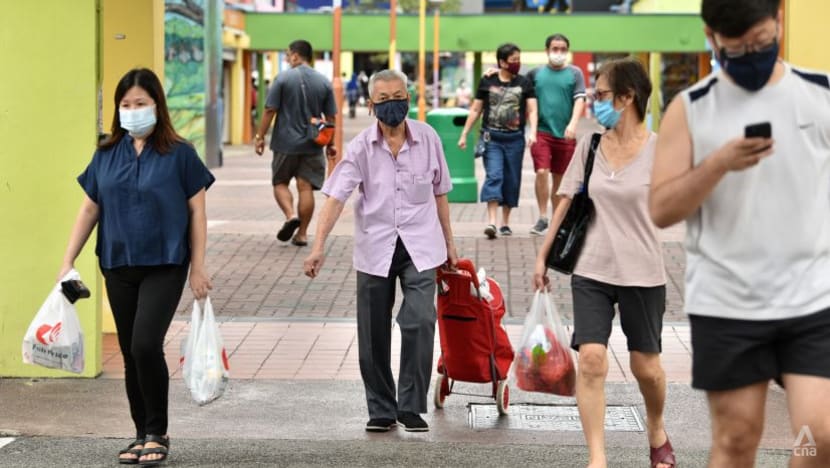Commentary: Is Singapore’s tax burden shifting toward GST and taxing individuals more than businesses?
The planned GST hike could add S$3.2 billion more in tax revenue, but Singapore needs a sustainable tax system to fund healthcare and other recurrent costs in the long run, says NUS Business School’s Simon Poh.

SINGAPORE: In his maiden Budget Speech on Friday (Feb 18), Minister for Finance Lawrence Wong finally announced that Singapore’s Goods and Services Tax (GST) rate will be increased first to 8 per cent in January 2023 and then to 9 per cent in January 2024.
Mr Wong said he had “carefully considered the overall situation” and understood Singaporeans’ concern about the tax hike coming at a time of global inflation, rising costs of living and a COVID-19 pandemic that does not seem to end, but that “our revenue needs are pressing”.
GST has always been among the top three contributors of government operating revenue, accounting for about S$12 billion in financial year 2021. The other two contributors are corporate income tax (CIT) and personal income tax (PIT), accounting for $17.5 billion and $13.8 billion respectively.
GST COULD BECOME THE TOP TAX REVENUE STREAM
With the 2-percentage point GST hike, experts expect to raise an additional S$3.5 billion in revenue - or about 0.7 per cent of Singapore’s gross domestic product.
In fact, GST could become Singapore’s largest tax revenue stream.
Additional GST revenue is expected with the introduction of new GST rules from January 2023 with GST extended to cover business-to-consumer (B2C) imported non-digital services and imported low-value goods.
Although PIT revenue will also be boosted with the increase in the top marginal PIT rate of 2 percentage points with effect from the Year of Assessment 2024, the projected increase generated at S$170 million is much lower than the revenue generated by GST.
Going forward, there is probably little scope to increase PIT revenue further, with a rapidly ageing population and continued low birth rates. With globalisation and many businesses offshoring operations, highly mobile, high-income earners might be tempted to relocate to cities with lower tax rates, such as Hong Kong.

Ongoing discussions under the OECD Base Erosion Profit Shifting (BEPS 2.0) may also mean reduced CIT revenue in the future.
Under BEPS, some multinational enterprises (MNEs) will need to re-allocate profit from where activities are conducted to where consumers are located, and this is expected to hurt tax revenue due to Singapore’s small domestic market and extent of activities conducted. Some MNEs may also be imposed a Minimum Effective Tax Rate of 15 per cent instead of current investment-friendlier rates and choose instead to relocate.
While these are early days and Singapore would do well to observe the experience of other countries and the behaviour of MNEs, it is not inconceivable that GST will end up being the biggest tax revenue stream.
SHIFT TOWARDS TAXING CONSUMPTION NOT NEW
Regardless of whether GST eventually overtakes both CIT and PIT, there is a clear trend of shifting from income tax to consumption tax over the last decades.
When Singapore was recovering from its first post-war recession back in 1986, one of the key recommendations of the 1986 Economic Committee, convened to respond to the recession and lead the nation to recovery, was to introduce GST and gradually increase GST revenue.
This would help Singapore be more competitive and attract investments, compared to the high 40 per cent CIT and top marginal PIT rate which were then slashed to sustain economic growth and create good jobs.
Other economies have also undertaken similar tax reform, cutting income tax rates to increase attractiveness to international investments and manpower, and structuring their tax system to rely more on GST.
For example, Ireland’s standard corporate tax rate was phased down from 40 per cent in 1995 to 12.5 per cent today, while standard value-added tax (VAT) rate was increased from 21 per cent in 1995 to the current 23 per cent. VAT is generally the second highest revenue generator for Ireland, behind individual income tax.
In Singapore, GST rates were raised from the initial 3 per cent to 4 per cent in 2003, 5 per cent in 2004 and 7 per cent in 2007 for the same reasons.
One advantage of taxing consumption is that it allows more revenue to be collected at relatively low tax rates. Consumption also grows in tandem with the economy. Taxing consumption creates fewer distortions on people’s desire to work hard and save, and does not require people to file tax returns or run the risk of capital flight.
Over the long term, GST offers a more stable revenue source, compared to income tax which is more directly affected by the state of the economy.
Rebalancing the tax mix is a fiscal policy priority. As Singapore’s average growth rates slow as its economy matures, reliance on pro-growth taxes like consumption and property taxes can avoid disincentivising work. OECD research also shows that a shift towards such less mobile taxes makes the tax system more resilient and less vulnerable to the effects of globalisation.
Although Mr Wong has clarified that carbon taxes will not significantly add to government coffers, a shift towards such environmental taxes is also in line with the ethos of developed nations pricing in externalities when it comes to climate and health.
How will the GST hike impact families and businesses? Listen to CNA's Heart of the Matter:
TAX BURDEN SHIFTED FROM BUSINESSES TO INDIVIDUALS?
With greater focus and reliance on GST, coupled with potential losses in CIT, does this mean Singapore’s tax burden is shifting from businesses to individuals?
It is tempting to come to this conclusion given that GST is a regressive consumption tax that affects most individuals.
But there is proactive targeted assistance to cushion the impact of GST and make the overall tax system fairer and progressive, ahead of the GST hike, including the permanent GST voucher scheme and the broader S$6.64 billion Assurance Package.
In fact, Singapore’s fiscal position actually shows that the largest contributor to our revenue does not come from tax, but the Net Investment Returns Contributions (NIRC) from our reserves. The NIRC in financial year 2021 was S$20.33 billion, larger than any tax revenue stream.
So perhaps, a fairer way to look at it is that Singapore and the Government need to generate a suitable source of revenue to fund its public expenditure.
And broadening the tax base to tap more on more forms of taxes, including income tax and GST judiciously can keep it sustainable for our public spending needs in the long term.
Simon Poh is Associate Professor (Practice) of the Department of Accounting at NUS Business School where he specialises in tax matters.




















